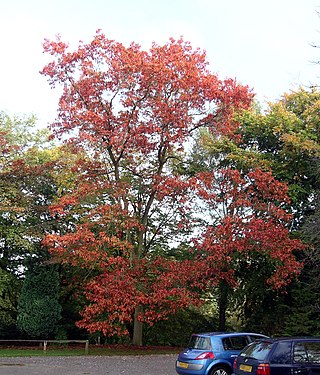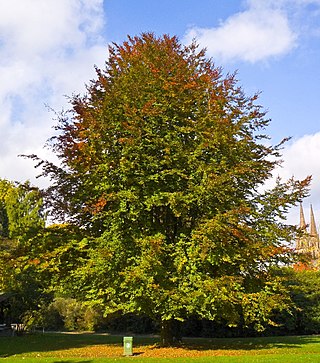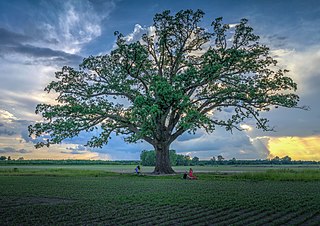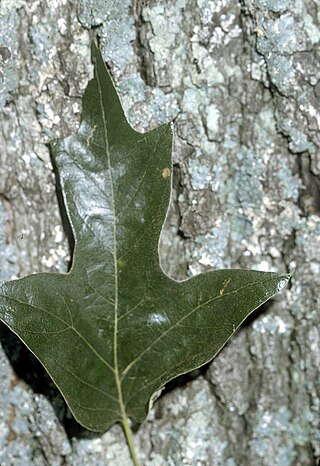
An oak is a tree or shrub in the genus Quercus of the beech family, Fagaceae. There are approximately 500 extant species of oaks. The common name "oak" also appears in the names of species in related genera, notably Lithocarpus, as well as in those of unrelated species such as Grevillea robusta and the Casuarinaceae (she-oaks). The genus Quercus is native to the Northern Hemisphere, and includes deciduous and evergreen species extending from cool temperate to tropical latitudes in the Americas, Asia, Europe, and North Africa. North America has the largest number of oak species, with approximately 160 species in Mexico of which 109 are endemic and about 90 in the United States. The second greatest area of oak diversity is China, with approximately 100 species.

Quercus rubra, the northern red oak, is an oak tree in the red oak group. It is a native of North America, in the eastern and central United States and southeast and south-central Canada. It has been introduced to small areas in Western Europe, where it can frequently be seen cultivated in gardens and parks. It prefers good soil that is slightly acidic. Often simply called red oak, northern red oak is so named to distinguish it from southern red oak (Q. falcata), also known as the Spanish oak. Northern Red Oak is sometimes called champion oak.

Quercus alba, the white oak, is one of the preeminent hardwoods of eastern and central North America. It is a long-lived oak, native to eastern and central North America and found from Minnesota, Ontario, Quebec, and southern Maine south as far as northern Florida and eastern Texas. Specimens have been documented to be over 450 years old.

The Fagaceae are a family of flowering plants that includes beeches, chestnuts and oaks, and comprises eight genera with about 927 species. Fagaceae in temperate regions are mostly deciduous, whereas in the tropics, many species occur as evergreen trees and shrubs. They are characterized by alternate simple leaves with pinnate venation, unisexual flowers in the form of catkins, and fruit in the form of cup-like (cupule) nuts. Their leaves are often lobed and both petioles and stipules are generally present. Their fruits lack endosperm and lie in a scaly or spiny husk that may or may not enclose the entire nut, which may consist of one to seven seeds. In the oaks, genus Quercus, the fruit is a non-valved nut called an acorn. The husk of the acorn in most oaks only forms a cup in which the nut sits. Other members of the family have fully enclosed nuts. Fagaceae is one of the most ecologically important woody plant families in the Northern Hemisphere, as oaks form the backbone of temperate forest in North America, Europe, and Asia, and are one of the most significant sources of wildlife food.

Quercus marilandica, the blackjack oak, is a small oak, one of the red oak group Quercus sect. Lobatae. It is native to the eastern and central United States.

Quercus muehlenbergii, the chinquapinoak, is a deciduous species of tree in the white oak group. The species was often called Quercus acuminata in older literature. Quercus muehlenbergii is native to eastern and central North America. It ranges from Vermont to Minnesota, south to the Florida panhandle, and west to New Mexico in the United States. In Canada it is only found in southern Ontario, and in Mexico it ranges from Coahuila south to Hidalgo.

Quercus robur, the pedunculate oak, is a species of flowering plant in the beech and oak family, Fagaceae. It is a large tree, native to most of Europe and western Asia, and is widely cultivated in other temperate regions. It grows on circumneutral soils in the lowlands and is notable for its value to natural ecosystems, supporting a very wide diversity of herbivorous insects and other pests, predators and pathogens.

Quercus bicolor, the swamp white oak, is a North American species of medium-sized trees in the beech family. It is a common element of America's north central and northeastern mixed forests. It can survive in a variety of habitats. It forms hybrids with bur oak where they occur together in the wild.

Quercus ilex, the evergreen oak, holly oak or holm oak is a large evergreen oak native to the Mediterranean region. It is a member of the Ilex section of the genus, with acorns that mature in a single summer.

Quercus suber, commonly called the cork oak, is a medium-sized, evergreen oak tree in the section Quercus sect. Cerris. It is the primary source of cork for wine bottle stoppers and other uses, such as cork flooring and as the cores of cricket balls. It is native to southwest Europe and northwest Africa. In the Mediterranean basin the tree is an ancient species with fossil remnants dating back to the Tertiary period.

Quercus petraea, commonly known as the sessile oak, Cornish oak, Irish Oak or durmast oak, is a species of oak tree native to most of Europe and into Anatolia and Iran. The sessile oak is the national tree of Ireland, and an unofficial emblem in Wales and Cornwall.

Quercus macrocarpa, the bur oak or burr oak, is a species of oak tree native to eastern North America. It is in the white oak section, Quercus sect. Quercus, and is also called mossycup oak, mossycup white oak, blue oak, or scrub oak. The acorns are the largest of any North American oak, and are important food for wildlife.

Quercus laevis, the turkey oak, is a member of the red oak group of oaks. It is native to the southeastern United States. The name turkey oak derives from the resemblance of the leaves to a turkey's foot. A Turkish and southern European species Quercus cerris is also commonly referred to as Turkey oak, so Quercus laevis is sometimes referred to as American turkey oak to distinguish it from the European species.

Quercus wislizeni, known by the common name interior live oak, is an evergreen oak, highly variable and often shrubby, found in many areas of California in the United States continuing south into northern Baja California in Mexico. It generally occurs in foothills, being most abundant in the lower elevations of the Sierra Nevada, but also widespread in the Pacific Coast Ranges—where since 1980 it has been known as a separate species Quercus parvula—and the San Gabriel Mountains. It was named for its collector, Friedrich Adolph Wislizenus (1810–1889).

Quercus falcata, also called southern red oak, spanish oak, bottomland red oak or three-lobed red oak is an oak. Native to the southeastern United States, it gets its name the "Spanish Oak" as these are the areas of early Spanish colonies, whilst "southern red oak" comes from both its range and leaf color during late summer and fall. The southern red oak is a deciduous angiosperm, so has leaves that die after each growing period and come back in the next period of growth.

Quercus coccifera, the kermes oak, is an oak bush in the Ilex section of the genus. It has many synonyms, including Quercus calliprinos. It is native to the Mediterranean region and Northern African Maghreb, south to north from Morocco to France and west to east from Portugal to Cyprus and Turkey, crossing Spain, Italy, Libya, Balkans, and Greece, including Crete. The Kermes Oak was historically important as the food plant of the Kermes scale insect, from which a red dye called crimson was obtained. The etymology of the specific name coccifera is related to the production of red cochineal (crimson) dye and derived from Latin coccum which was from Greek κόκκος, the kermes insect. The Latin -fera means 'bearer'.

Quercus ilicifolia, commonly known as bear oak or scrub oak, is a small shrubby oak native to the eastern United States and southeastern Canada. Its range extends in the United States from Maine to North Carolina, with reports of a few populations north of the international frontier in Ontario. The name ilicifolia means "holly-leaved."

Quercus rotundifolia, the holm oak or ballota oak, is an evergreen oak native to the western Mediterranean region, with the majority on the Iberian Peninsula and minor populations in Northwest Africa. The species was first described by Jean-Baptiste Lamarck in 1785. It is the typical species of the Iberian dehesa or montado, where its sweet-astringent acorns are a source of food for livestock, particularly the Iberian pig. Its acorns have been used for human nourishment since the Neolithic era. It is placed in section Ilex. It has previously been described in the same species as Quercus ilex.

Quercus geminata, commonly called sand live oak, is an evergreen oak tree native to the coastal regions of the subtropical southeastern United States, along the Atlantic Coast from southern Florida northward to southeastern Virginia and along the Gulf Coast westward to southern Mississippi, on seacoast dunes and on white sands in evergreen oak scrubs.

















